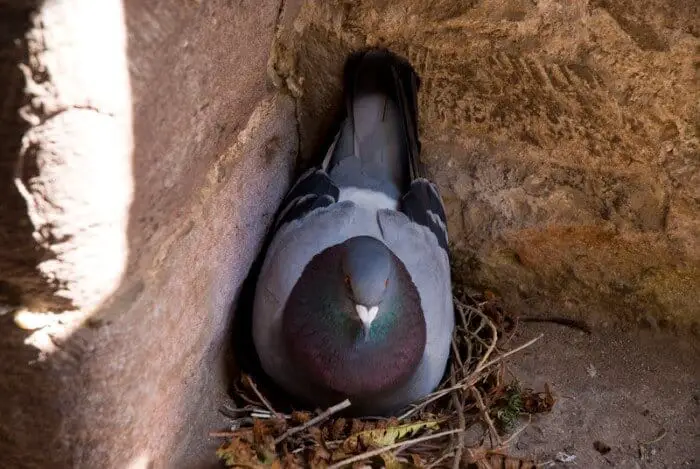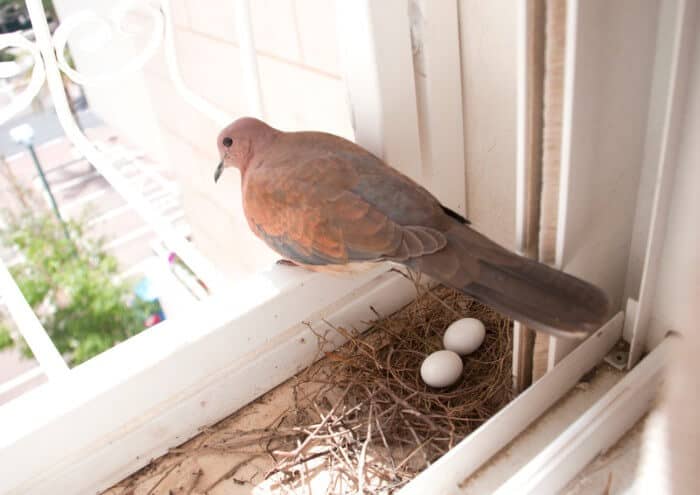Pigeons will nest anywhere that is out of reach and offers some protection against the elements.
Common places for pigeons to nest include; abandoned buildings, roofs, attics, beams, guttering, chimneys, ledges, under bridges, railway stations, statues, on air conditioning units, barns, sheds and trees.
Pigeon Nests

The average size of a pigeon’s nest is around 7 inches in height and about 19 inches wide.
They build their nests out of whatever nesting materials they can find, this typically includes things such as sticks, leaves, and straw. As the same pair will reuse the same nest time after time their otherwise flimsy structure becomes strong and more rigid because of their droppings.
The droppings act like cement and clue it all together.
Where Pigeons Nest
- Urban pigeons that we see in our city centres will nest in buildings that are occupied or abandoned. They have a close relationship with mankind because of the feeding opportunities. They are to be found inside roofs or attics, using the beams as rests for their nests and especially under the eaves.
- As stated in the introduction, they love old buildings because there are so many places to build nests. That’s why our old historical buildings and landmarks need to be cleaned every so often. Pigeon droppings contain acid which eats into the stone and damages them.
- Guttering is also a suitable nesting site. Their shape provides the perfect receptacle for a nest.
- Chimneys have always been a favourite spot for building nests too. Back in the days of coal fires many people had to clear blockages from their chimneys because a pigeon had fallen in, couldn’t get out, and died inside.
- Ledges of all kinds, on modern or old buildings make great platforms for nests.
- Pigeons love nesting under solar panels as these are warm, dry and out of the way of predators.
- Under bridges, especially those with a multitude of struts and girders are also nesting sites. Where two pieces of metal meet provides an ideal niche and anchor on which to build a nest.
- Most railway stations host pigeons and other birds’ nests high up in their rafters.
- Pigeons have been known to roost in statues.
- Pigeons even use air conditioning units, placing their nests on top, behind, and even inside in some cases.
- In the countryside, pigeons will inhabit barns and sheds.
- Wood pigeons use trees and so aren’t seen as pests.
In fact, pigeons will nest anywhere that is out of reach and offers some protection against the elements. They are opportunist builders and they are the ultimate squatters.

Control of Pigeons
People may not mind pigeon nests on their property, but they may be bothered by their cooing and droppings.
If pigeons plague your residence, there are precautions you can that to discourage them from nesting on your building or in your garden you can try some of these pigeon deterrents:
- Mobile and inflatable scarecrows
- Audio and visual devices.
- Mild electric shock wires and meshes.
- Plastic or steel spikes placed where they roost or perch.
- Netting.
- Chimney cowls.
- Repellent sprays.
Be mindful that these methods may well discourage and deter other birds from your garden too so don’t use them unless the pigeons are a serious problem.
If you have a problem with pigeons don’t take any action until you have contacted the Pigeon Control Resource Centre, which comes under the Department of Environment, Food and Rural Affairs. The regulations for the control of pigeons, lethal or otherwise, are laid out in the Animal Welfare Act 2006.
If a pest control contractor breaks the law while hired by you, you, not the contractor, may be liable to prosecution.
In Conclusion
There you have it, basically, pigeons build their nests wherever they feel fit. They aren’t socially responsible creatures. They may seem pretty dumb to you, strutting along, cooing, moving their heads like they are listening to some hidden beat, but scientists will tell you different.
Studies have shown that pigeons can recognise themselves in a mirror, only one of six species in the animal kingdom that can do so. Pigeons have also won special medals for animal valour in times of war, when the messages they have carried have saved lives.
Unfortunately, probably their greatest contribution to the world are their droppings. If they drop on you, don’t worry, it’s supposed to be a sign of good fortune.
